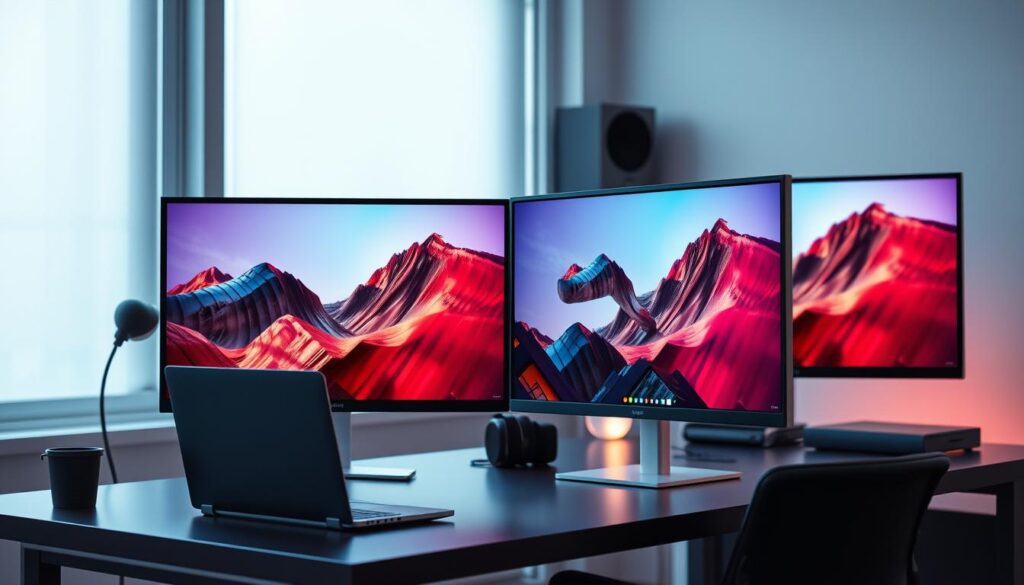Choosing the right notebook can make a big difference. It’s not just about finding any notebook. It’s about finding one that fits your lifestyle perfectly.
Intel and AMD are leading the tech world with their processors. If you need to do lots of tasks at once, an Intel Core i5 is a great choice.
When it comes to storage, SSDs are faster than HDDs. SSDs make your notebook quick, while HDDs are cheaper but slower. Most people find 250 to 500 GB of storage just right.
Battery life and ports are also important. Qualcomm Snapdragon X CPUs offer fast performance and long battery life. This means you can work or play for hours without needing to charge.
Choosing the right notebook is all about finding one that fits your needs. This guide will help you understand the technical stuff and find a notebook that tells your story.
Determining Your Ideal Notebook Operating System
When choosing a notebook operating system, we face a big decision. This choice affects how you use your device every day. It also impacts what software you can run.
Understanding Compatibility with Software Needs
Each operating system has its own strengths. If you need specific software for work, your choice is crucial. For example, creatives might choose macOS for its compatibility with editing tools. On the other hand, tech professionals might prefer Linux for its flexibility.
Overview of Available Operating Systems
Let’s look at the main options:
| Operating System | Best For | Common Devices |
|---|---|---|
| Windows | Versatility in applications, business environments | Various brands from high-end to budget |
| macOS | User-friendly interface, creative tasks | MacBooks |
| Chrome OS | Web-based applications, budget-friendly solutions | Chromebooks |
| Linux | Programmers and developers, customizable setups | Can be installed on a variety of hardware |
Your notebook operating system choice is key to using your device well. Whether it’s Windows for its wide range, macOS for ease, Chrome OS for savings, or Linux for tweaking, pick wisely. Think about your main tasks and software needs to make a choice that fits your goals.
Analysing Processor Capabilities for Optimal Performance
When we explore notebooks, the processor is key. It greatly affects how well a notebook works. So, doing a notebook CPU comparison is vital for anyone buying a new device. Knowing about Intel Core and AMD Ryzen processors helps a lot, whether you’re doing simple tasks or gaming.
Deciphering Processor Naming Conventions
Let’s break down processor names. They might look confusing at first. For example, Intel Core i7-1455U tells us a lot. ‘i7’ means high performance, ‘1455’ shows specific features, and ‘U’ means it’s energy-efficient for laptops.
AMD names like Ryzen 5 8600X also tell us a lot. ‘Ryzen 5’ means it’s in a certain family, ‘8600’ shows its performance level, and ‘X’ means it’s extra powerful.
Intel vs. AMD: Choosing the Right CPU
In the notebook CPU comparison fight, Intel and AMD have their strengths. Intel is known for its strong multi-core performance and energy saving. This is great for work and multitasking.
AMD, on the other hand, is known for its strong graphics. This makes AMD Ryzen processors a top choice for creatives and gamers who don’t need an external GPU.
It’s important to know these differences. AMD is better for multimedia tasks because of its great GPU performance. Intel is better for tasks that need lots of processing power and energy saving.
Both Intel and AMD keep improving their processors. They add more cores, increase speeds, and improve power management with each new generation.
Architecture also matters a lot. When choosing between an Intel Core i9 and an AMD Ryzen 9, think about software compatibility. Both Intel and AMD use x86 architecture and keep pushing performance limits.
In short, whether you choose Intel Core or AMD Ryzen, it depends on your needs. Look into each processor’s features, compare them well, and choose wisely. The right processor affects your notebook’s performance and its future in the tech world.
Evaluating Graphics Cards for Superior Visuals
Choosing the right graphics card is key for the best visuals on your notebook. For those who love high-resolution gaming or graphic design, a dedicated graphics card is essential. Unlike integrated GPUs, a dedicated card offers better performance and enhances best notebook features.
There’s a wide range of dedicated GPUs for different needs. For example, the AMD Radeon RX 7600 is great for mainstream gaming at 1080p. It’s a good balance of cost and performance. For high-refresh gaming at 4K, the Nvidia GeForce RTX 4090 is a top choice, but it’s more expensive.
| Graphics Card | Use Case | Price on Amazon |
|---|---|---|
| Nvidia GeForce RTX 4060 | High-Refresh Gaming at 1080p | $304.97 |
| AMD Radeon RX 7700 XT | Mainstream Gaming at 1440p | $409.99 |
| AMD Radeon RX 7900 XT | Mainstream Gaming at 4K | $1,099.99 |
| Intel Arc A580 | Best Budget Graphics Card | $179.97 |
| Nvidia GeForce RTX 4090 | High-Refresh Gaming at 4K (Nvidia) | $2,999.99 |
The Intel Arc A580 is a great choice if you’re on a budget. It shows that you can get good gaming and graphics without spending a lot.
In conclusion, whether you choose the Intel Arc A580 or the Nvidia GeForce RTX 4090, a dedicated graphics card is vital. It’s essential for anyone serious about using the best notebook features for graphics.
Considering Portability for On-the-Go Usage
Choosing the right notebook is key, especially for those who are always on the move. Whether you’re a traveler, student, or professional, a lightweight laptop makes a big difference. It can simplify your daily life.
Weight and Screen Size for Portability
The weight and screen size of your notebook are crucial for portability. Laptops under 4 pounds are great for those always on the go. For example, the ASUS Vivobook Go is known for being both durable and light.
Screen sizes of 13 to 14 inches are ideal. They offer enough space for viewing while being easy to carry.
Travel, Students, and Professionals: Matching Needs with Specifications
Travel notebooks are made to be small and have long battery life. They’re perfect for those always on the move. Student laptops focus on being affordable and durable. They aim for a balance between weight and performance.
Professional laptops, however, often have better performance specs. They might be a bit heavier but have more power and storage.
When choosing a laptop, look for lightweight models with strong batteries and good connectivity. USB-C is a good choice for fast charging and data transfer, as ASUS’s business travel laptop selection tips suggest. Find a laptop that meets your specific needs for travel, study, or work. The right one can greatly improve your mobility and productivity.
Selecting the Right Amount of RAM and Storage
When looking for a new notebook, knowing about ideal RAM and storage options like HDD vs SSD is key. These choices affect your satisfaction and the device’s performance. Let’s dive into these important factors for better notebook purchasing advice.
Importance of RAM for Multitasking
To handle multitasking well, finding the right RAM is essential. For simple tasks on Windows 10, 8GB is a good start. But, for those who use many apps or run demanding software, 16GB is better. DDR4 memory, which has been around for seven years, boosts multitasking compared to DDR3.
Professionals or heavy users might want 32GB or more. This ensures their system can handle demanding tasks and stay up-to-date.
Differences Between HDD and SSD
Choosing between HDD and SSD affects your notebook’s speed and efficiency. HDDs offer lots of storage at a lower cost, great for storing lots of media. On the other hand, SSDs are fast and durable, making your notebook start up and apps load quickly.
Many new notebooks now have a mix of both, combining HDD’s storage with SSD’s speed. This offers a good balance for storage needs.
Thinking about RAM and storage options is crucial. Your choice greatly influences your notebook’s usability and performance. Make sure to match these choices with your needs for the best value.
Choosing the Best Display for Your Needs

When picking a new notebook, the screen quality for notebooks is key. It matters whether you’re a student, worker, or love watching movies. High-resolution displays make images sharp, perfect for detailed work or watching movies.
Screen sizes also vary, fitting different needs and places. Here’s what to think about when picking your notebook’s display:
| Screen Size | Resolution | Common Uses |
|---|---|---|
| 10.5″ – 13″ | 1536 x 1024 and up | High portability; school, travel |
| 13.5″ – 15″ | 1920 x 1080 – 2880 x 1920 | General use; professional tasks |
| 15″+ | 2400 x 1600 and up | Entertainment; multitasking |
Larger screens give more room for work and fun, but are heavier. Smaller screens are light but might not be best for detailed work or long watching.
New screen tech like OLED and IPS panels boost display quality. OLED shows colors and contrast like real life. IPS panels have wide views and colors that stay the same, great for sharing screens.
Think about where you’ll use your notebook. A matte screen is good for outside or bright places because it cuts glare and reflections.
A good display makes watching and working easier and less tiring. So, pick wisely based on what you like and need.
Understanding the Importance of Battery Life
Choosing the right notebook means looking at notebook battery life. A good guide will show you how long-lasting batteries make a big difference. This is especially true for those who are always on the move.
Think about how your notebook’s battery fits your daily use. If you’re always on the go, you don’t want your notebook to run out of power. Knowing your notebook’s battery and how it works is key.
Comparing Battery Capacity and Usage Patterns
Checking a notebook’s battery is a good first step. Look for high Watt-hours (Wh) or milliamp-hours (mAh) values. This is important if you need your notebook to last a long time between charges.
But, remember that some laptops use more power. For example, gaming laptops have powerful CPUs and screens. This means they might drain their batteries faster.
Impact of Features on Battery Longevity
Features like screen resolution and processor type also matter. A higher screen resolution uses more power. The same goes for the CPU; a more powerful one might use more battery.
Also, laptops with solid-state drives (SSDs) tend to last longer than those with hard disk drives (HDDs). SSDs use less power. Light tasks like editing documents or browsing the web use less battery than heavy tasks like video editing or gaming.
In short, when looking at notebooks, use notebook comparison tips to find the right one. Choose a notebook that meets your needs and has great battery life. A good notebook fits your lifestyle and keeps you going without needing to find a power source all the time.
Testing Connectivity and Expansion Options
When looking for a new notebook, knowing its notebook connectivity options is crucial. These features greatly impact your choice. They also shape how you’ll use future tech.
Essential Ports for Peripherals
Let’s explore the essential ports a notebook needs. You want USB types, HDMI for screens, and Ethernet for the internet. Thunderbolt and DisplayPort are also key.
These ports let you connect many devices, transfer big files fast, and link to gaming consoles. They make your notebook more useful.
Future-Proofing with Expansion Capabilities
Ensuring your notebook stays relevant is key. This is where expansion capabilities come in. A notebook that can adapt to new tech is a smart choice.
Look for notebooks that meet today’s needs and tomorrow’s. Notebook connectivity options should include the latest USB tech and support for new hardware.
| Port Type | Usage | Benefits |
|---|---|---|
| USB-C | Multipurpose (charging, data transfer) | Fast speed, reversible plug |
| HDMI | Video output | Supports high-definition video and audio |
| Ethernet | Internet connectivity | More stable and faster than WiFi |
| Thunderbolt 3/4 | Data, video, and power | High bandwidth, versatility |
Choosing a notebook with all the right ports and expansion options is crucial. It meets your current needs and prepares for future tech. This makes your device future-proof.
Assessing Display Quality and Screen Size
Choosing the right laptop means understanding the link between notebook display quality and optimal screen size. These factors are key, whether you’re a graphic designer or just browsing online.
Notebook display quality includes resolution, color accuracy, and panel technology. You can find everything from HD to 4K screens. IPS panels offer great viewing angles and color, perfect for precise work.
The right optimal screen size affects how portable and useful a laptop is. Smaller screens, 11 to 14 inches, are great for those on the move. Larger screens, 17 inches and up, are better for work and gaming, with more detail and wider views.
Laptops like the ASUS ROG Strix G16 show how high-resolution screens improve gaming. For more on its display and features, check out this review.
| Size | Utility | Resolution |
|---|---|---|
| 11-14 inches | High portability, reduced power consumption | HD to Full HD |
| 15-17 inches | Balanced for both travel and productivity | Full HD to 4K |
| 17 inches and above | Ideal for detailed graphics work and gaming | 4K and higher |
When picking a laptop, think about the display quality and screen size. The right display can make a big difference in your experience. The screen size should match your needs, finding a balance between function and comfort.

Security Measures: Safeguarding Your Notebook
In today’s world, keeping your digital data safe is key. Knowing about notebook security features is vital for protecting your personal and work information. Laptops are often stolen, with about 1,800 taken every day in the U.S. This makes built-in security very important.
Did you know that thefts of laptops can be reduced by as much as 95% by following top security tips?
Today’s notebooks come with many security tools to keep your data safe. Features like fingerprint scanners and facial recognition help stop unauthorized access. These tools give you peace of mind, knowing your data is well-protected.
For example, over 98 percent of laptops sold in the last five years have security slots for cable locks. This simple feature helps prevent theft.
| Security Feature | Availability | Price Range |
|---|---|---|
| Cable Locks | 98% of laptops | $20.00 – $50.00 |
| Encryption software | Highly recommended | Varies |
| Two-factor Authentication | Recommended | Free to low cost |
When a laptop is lost, you lose more than just the device. You risk exposing personal photos and important work data. Simple steps like changing passwords regularly and using two-factor authentication can help protect your data.
Using encryption tools like BitLocker for Windows or FileVault for macOS adds extra security. It makes your data unreadable to anyone who doesn’t have the right access, even if your laptop is stolen. Adding a webcam cover also helps protect your privacy by blocking unwanted surveillance.
As cyber threats grow, having strong notebook security is more important than ever. By staying informed and using these security tools, you can keep your notebook safe from common threats. This ensures your data stays private and secure.
Exploring Upgradability and Long-Term Value
When you buy a notebook, don’t forget about notebook upgradability. Knowing if you can upgrade RAM and storage is key for its long-term notebook value. Being able to upgrade keeps your notebook useful for longer and helps the planet by reducing waste.
Choosing a notebook that can be upgraded is a smart move. It saves you money over time. Swapping out old parts for new ones keeps your notebook from becoming outdated and extends its life.
For example, the Samsung Galaxy Book series, like the Galaxy Book4 Ultra, offers high-performance Intel® Core™ processors and upgrade options. Starting with an Intel® Core™ 7 processor meets your current needs. But, as your needs grow, upgrading to an Intel® Core™ Ultra 9 processor is a big plus.
Also, buying a notebook that can be upgraded is good for the environment. It’s a smart choice that saves money and helps the planet. It means you don’t have to buy new devices as often, reducing electronic waste.
In short, think about a notebook’s upgrade potential when you’re shopping. A notebook’s upgradability greatly impacts its usefulness, performance, and value over time. It’s a wise investment for the future.
Conclusion
Choosing the right notebook is a detailed and personal process. It’s about finding the perfect balance between technical features and your own needs. This creates a harmonious tool that you can rely on.
Our final thoughts on notebook purchasing advice highlight the importance of various factors. These include the operating system, processor power, and graphics card quality. All these elements come together to create an experience that’s just right for you.
Think about what matters most to you, like mobility or sustainability. For example, the Piko Pocket Notebook is lightweight and durable. Or, if you care about the environment, consider Lovely Store’s eco-friendly notebooks.
Look for a notebook that’s easy to carry and has a great display. It should also have long battery life. Lovely Ruled Notebooks are a great example of this.
Consider your current needs and future plans when choosing a notebook. Features like connectivity and security are key. The Kaco Right Choice A5 Spiral Notebook has a waterproof cover, making it durable for daily use.
Also, think about how easy it is to upgrade your notebook. This ensures it stays useful and relevant over time. By keeping these points in mind, you’ll make a smart choice for your next notebook.






